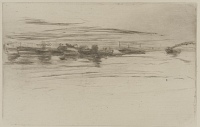Steamboat Fleet, Chelsea | ||
| Number: | 155 | |
| Date: | 1875/1877 | |
| Medium: | drypoint | |
| Size: | 139 x 215 mm | |
| Signed: | no | |
| Inscribed: | no | |
| Set/Publication: | 'Cancelled Plates', 1879 | |
| No. of States: | 2 | |
| Known impressions: | 19 | |
| Catalogues: | K.156; M.153; W.223 | |
| Impressions taken from this plate (19) | ||
KEYWORD
bridge, paddle-steamer, river, rowing boat, steamboat, warehouse.
TITLE
The subject is a fleet of steamboats, as reflected in the various titles, as follows:
Possibly 'Steamboats laid up' (1877, Charles Augustus Howell (1840?-1890)). 1
'Steamboat Fleet' (1886, Frederick Wedmore (1844-1921)). 2
'Steam boats fleet Chelsea' (1887, Whistler). 3
'Steamboat's Fleet, Chelsea' (1892, Sotheby's). 4
'The Steamboat Fleet' (1903/1935, possibly Rosalind Birnie Philip (1873-1958)). 5
'Opposite Lindsay Row, or Steamboat Fleet' (1904, Grolier Club). 6
'Steamboat-Fleet' (1909, Howard Mansfield (1849-1938)). 7
It is curious that this title was not recorded by Whistler in his studio inventories. 'Steamboats laid up', sold in 1877, could equally have referred to Steamboats off the Tower [156], and so is not a reliable title.
However, the title 'Steam boats fleet Chelsea', as sold by Whistler in 1887, was confirmed by Sotheby's in 1892, and forms the basis for the current title, 'Steamboat Fleet, Chelsea'.
Possibly 'Steamboats laid up' (1877, Charles Augustus Howell (1840?-1890)). 1
'Steamboat Fleet' (1886, Frederick Wedmore (1844-1921)). 2
'Steam boats fleet Chelsea' (1887, Whistler). 3
'Steamboat's Fleet, Chelsea' (1892, Sotheby's). 4
'The Steamboat Fleet' (1903/1935, possibly Rosalind Birnie Philip (1873-1958)). 5
'Opposite Lindsay Row, or Steamboat Fleet' (1904, Grolier Club). 6
'Steamboat-Fleet' (1909, Howard Mansfield (1849-1938)). 7
It is curious that this title was not recorded by Whistler in his studio inventories. 'Steamboats laid up', sold in 1877, could equally have referred to Steamboats off the Tower [156], and so is not a reliable title.
However, the title 'Steam boats fleet Chelsea', as sold by Whistler in 1887, was confirmed by Sotheby's in 1892, and forms the basis for the current title, 'Steamboat Fleet, Chelsea'.
1: C. A. Howell to Whistler, [6-15 Nov. 1877], GUW #02178; 9-11 Nov. [1877], #12738.
2: Wedmore 1886 A (cat. no. 223).
3: To Dowdeswell's, 27 July 1887, GUW #13024.
4: J. H. Hutchinson sale, 3 March 1892 (lot 321).
5: Envelope containing copper plate, Hunterian Art Gallery.
6: New York 1904a (cat. no. 236).
7: Mansfield 1909 (cat. no. 153).
DESCRIPTION
Three side-wheel paddle steamers are moored at the far side of the River Thames. Behind and to right of them are low warehouses and tall chimneys against a cloudy sky. At far right is a landing-stage and part of a curved iron bridge.
SITE
The River Thames, with glimpses of the Battersea shore, as seen from Lindsey Row in Chelsea, London.
Wedmore described it: 'A memorandum in dry-point of little paddle steamers side by side,' implying that it was not drawn on site, but since Whistler could see this view from his house in Lindsey Row it seems more likely that he worked directly from nature. 8
8: Wedmore 1886 A (cat. no. 223).
DISCUSSION
